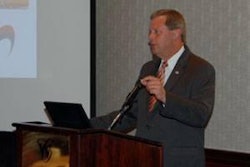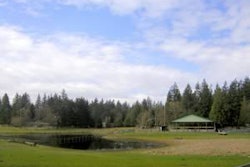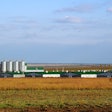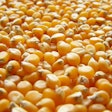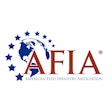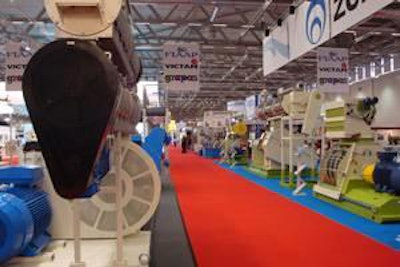
Representatives of the feed and grain sectors from more than 100 companies were in Germany in early May to take part in the 2011 edition of the specialist trade show Victam International, that deals exclusively with grain processing and the manufacture of animal feeds. With European-style mega-booths for the big feed equipment players, the show also included demonstrations of some major machinery.
Victam of 2011 marked the event’s first time in Germany after several decades of being located in the Netherlands. Staged in the German city of Cologne, this 16th in a series going back to 1964 was the biggest yet – with a show floor area about 23% bigger than at the previous edition held in 2007.
Feed trials centre project
Among the exhibitors were some who expressed their hope that an American or Canadian company involved in making animal feeds might consider joining them in a project to create an international facility for the development of new feed products. The plan they unveiled would have a starting budget estimated at about US$5 million, representing an investment by a collection of industry suppliers and feed manufacturers to provide an independent centre where ingredients and formulations could be tested under controlled conditions using the latest technology.
Four companies from the Netherlands are behind the plan – equipment company Dinnissen Process Technology, feed products supplier Vitelia, ingredients specialist DSM and software house Imtech. Their concept is of a facility capable of production runs from 200 kg to 2000 kg per hour and with all processing stages from grinding to extrusion.
They hope now to be joined by one or two manufacturers of complete feeds or premixes to complete the team of founders, and they say that a partner from North America would most definitely be welcome in this capacity. The proposed centre will contain system components from a range of suppliers, they emphasized, and will be open to any developer to use on a confidential basis. Additionally, it will likely have an international training role in introducing young people from various countries to the different parts of the feed manufacturing process.
Product tests and fishmeal
Conversations among visitors to the Victam feed show ranged from safety tests on products to European decisions about fishmeal. Recent incidents involving the accidental contamination of animal feeds with dioxins were recalled in Cologne, with indications that there will be further product testing to certify feeds as safe. Countries such as South Africa have signaled that they want to start their own testing of feed products for dioxins instead of requiring that local feed companies send samples abroad to be examined.
Fishmeal entered the scene when discussions turned to an impending announcement expected from the European Union’s regulators on the subject of feeds certified as organic (or biological; the terminology used in some parts of Europe). As from the start of January 2012, European feeds with an organic certification must contain exclusively organic ingredients for all parts of the diet except for the mineral/vitamin component. A key question is whether EU legislation will accept fishmeal within the organic-only classification.
Currently, fishmeal can be used as part of a 5% allowance covering agriculturally derived ingredients from non-organic sources. Poultry feed producers regard it as the only feasible source of methionine and lysine for their organic diets as they are denied use of synthetic amino acids.
Probiotics as gut flora stabilizers in farm animals moved onto the agenda when the not-for-profit European Probiotic Association called a meeting to present the researchers who form its newly created scientific committee. This committee is mainly charged with advising the association on future directions and opportunities for the development of probiotic applications in animal feeding.
These are enormously exciting times to be studying gut function, said committee member professor Jamie Newbold of the University of Aberystwyth in Wales. New techniques have arrived to assist with measuring and demonstrating how micro-organisms work within the gut and rumen. Especially, DNA technology allows the profile of the gut flora to be seen to an extent not possible in the past, opening the way for the scientist to recommend when and how different probiotic products may be used successfully.
Grinding and pelleting
Among the machinery displays at Victam, examples of new products included Buhler of Switzerland’s exhibit of its compact DPEF Kubex pellet mill that highlighted energy savings obtainable from the fact that the machine features efficient direct drive, in addition to extra access to the die from both sides by sliding doors. Coinciding with the opening of the show, Buhler Technology Group had announced its purchase of pelleting dies/rollers manufacturer Tijdhof Persmatrijzen in the Netherlands so that all parts for pellet-mills will now be supplied from a single in-house source.
Dutch company Van Aarsen demonstrated the easy-change automatic screen exchange on the low-energy GD-1400 hammer mill, in which there is a cassette holder for three screens without adding significantly to overall dimensions, plus frequency control on the main motor to optimise grinding. ZCME from China presented a direct-drive H558D pellet mill for aqua and poultry feeds offering a capacity of up to 22 metric tons per hour, or about 15% more than from belt-driven versions. From the Netherlands, Geelen Counterflow brought along a new Mark-2 counterflow cooler described as suiting mills that have very high requirements for sanitation and inspection, together with a big Mark-2 counterflow batch dryer. Wijnveen introduced a double-shaft paddle mixer designed to be practically self-cleaning and capable of discharging batches completely without leaving residues behind that might lead to cross-contamination. European Machine Trading presented a portable system for the filling of big bags used in the onward transportation of meals or granules.
Advances in extrusion
Processes for granulation and extrusion/expansion were strongly represented throughout the fair. Examples included a Crown Expander shown by Amandus Kahl of Germany, featuring a modified outlet to the barrel so that more uniform pellets can be produced without compromising on the coarse particle structure of the product. US-based Insta-Pro used its Victam booth to show how the cutter head assembly is now integrated into the extruder on a swinging arm to save time and space, while access to change dies is made easier by a redesign of the safety guard.
Andritz Feed & Biofuel from Denmark showcased the new EX-1021 extruder line with dual conditioning chambers and the ability to process fish feeds and pet foods at rates of up to 12 metric tons per hour. Dinnissen Process Technology of the Netherlands launched a Magi-N.ext line of extruders for feeds and pet foods as offering a wide range of possibilities for products achievable from a single production line, with large inspection hatches and easy-to-clean features allowing a rapid changeover of product types. There was also an FE-100 extruder from Farmet of the Czech Republic, exhibited as suitable even for smaller-scale operation by integrated farms that mix their own feed.

